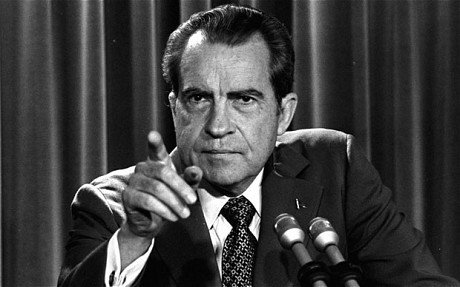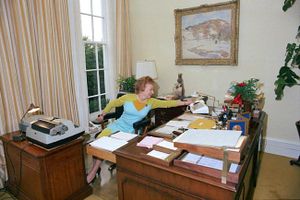The Watergate Tapes (lost 18½ minute gap of audio recordings of American President; 1972)
On June 17th, 1972, five burglars were caught rummaging through the Democratic National Committee's office at the Watergate complex in Washington D.C.; the discovery that these men were associated with then-U.S. president Richard M. Nixon led to a thorough investigation from members of Congress into Nixon's involvement with the break-in and his efforts to cover it up. The affair surrounding this investigation, which would eventually culminate in Nixon's own resignation in 1974 while on the brink of a presumably unwinnable impeachment trial, has come to be known as the Watergate Scandal.
During the Watergate investigation, it came to light that Nixon recorded many of his conversations, phone or otherwise, in the White House for his own records. While he wasn't the first president to do this, with Lyndon B. Johnson and John F. Kennedy doing it before him, Nixon's, in particular, were unusually frequent and comprehensive. While Nixon's team initially refused to provide public access to these recordings, the U.S. Supreme Court unanimously declared that executive control over them was unconstitutional before ordering their release. It was from these tapes that numerous crucial conversations between Nixon and his associates would be revealed, including one in which Nixon explicitly ordered a cover-up of the Watergate investigation; it was from this particular "smoking gun" tape that Nixon would eventually be forced to resign the office of the presidency, no longer able to deny his involvement in the break-in.
While it is now common knowledge that Nixon was guilty in his breaches of federal law through his involvement in Watergate, one aspect of the investigation still remains unclear: an 18½-minute portion of audio that had been erased from one of the tapes. Nixon's secretary, Rosemary Woods, claimed that she inadvertently wiped that portion of the tape while answering the phone: according to her account, she had accidentally hit the record button on her Uher 5000 instead of the stop button, re-recording roughly five minutes of the tape. The erasure of the other 13½ minutes supposedly occurred while she was listening to the portion she had re-recorded. Woods' reenactment of her version of the incident was viewed as dubious by Nixon's opponents, who accused Nixon of having erased the 18½ minutes himself.[1]
In the years following Nixon's resignation, conspiracy theorists have devised a number of explanations regarding the tape's contents, accusing Nixon of various wrongdoings. Theories of what the audio contained ranges from a deal with terrorists to war plans with the Soviet Union. Given the initial recording date of the tape (June 20th, 1972, just three days after the Watergate burglary), it can be assumed that if the audio on the tapes did contain anything incriminating (as opposed to insignificant conversations with members of White House staff), it would most likely be dialogue relating to the Watergate cover-up.
Video
References
- ↑ Archived New York Times article discussing the tapes and the missing audio. Retrieved 24 May '21

